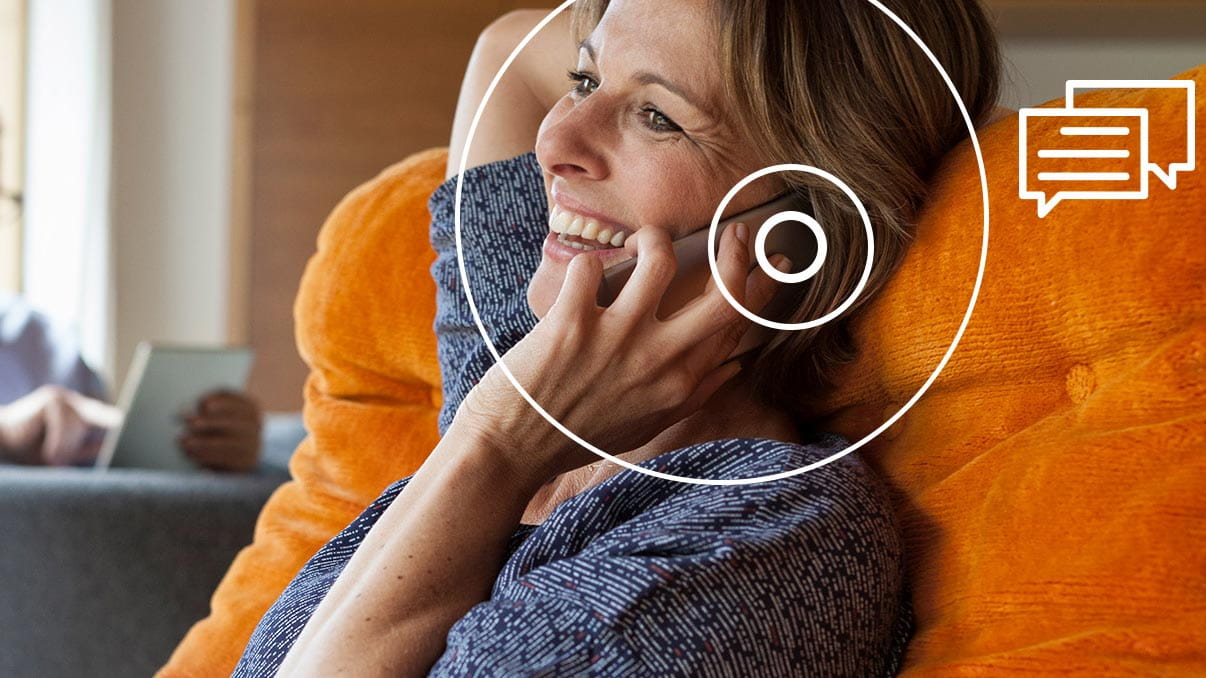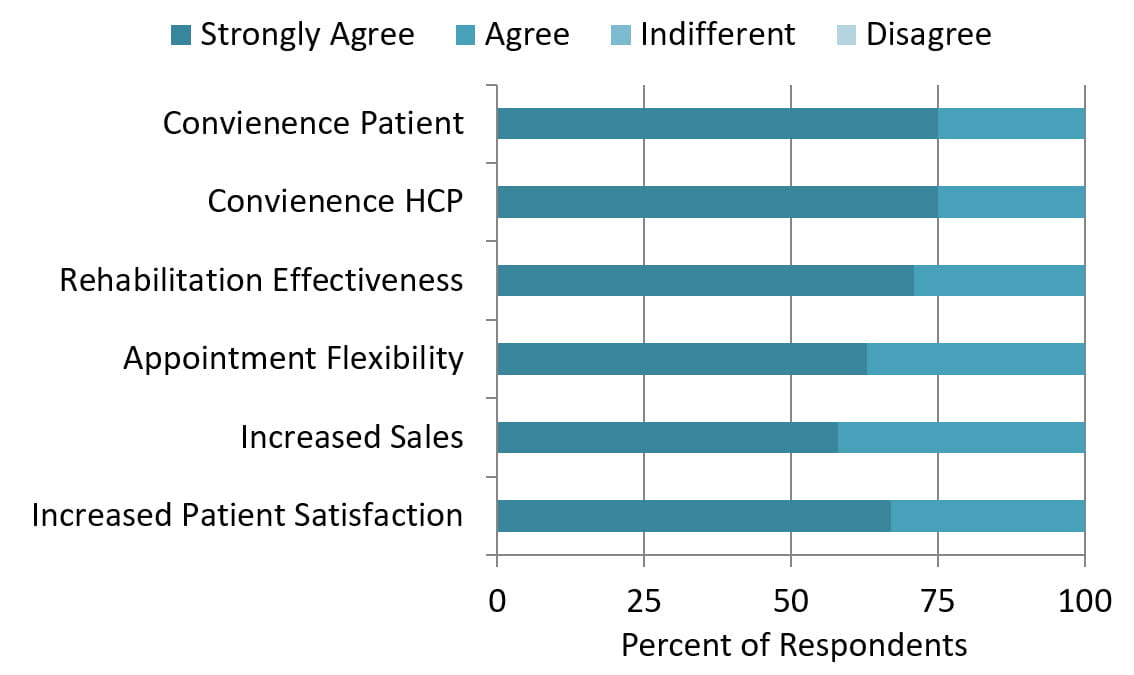
Achieving Excellence In Customer Service with TeleCare
One of the main concerns of Hearing Care Professionals (HCPs) who are fitting and dispensing hearing aids is knowing how to achieve excellence in patient service. A study involving 88 HCPs and more than 5600 first time users revealed the benefit of Signia TeleCare in creating higher hearing aid adoption rates with patients. The use of TeleCare was also found to result in high user satisfaction ratings in all the most relevant hearing situations for the individuals.
The findings showed that a careful and consistent implementation as part of the HCP’s patient care workflow was key to leverage the remote care potentials provided by Signia TeleCare.
One of the main concerns of Hearing Care Professionals (HCPs) who are fitting and dispensing hearing aids is knowing how to achieve excellence in patient service. But what is excellence? Excellence is more than simply serving our patients the appropriate way, it is surprising them by going beyond what is expected. Excellence is the combination of effectivity and efficiency.
A strong relationship with our patients is an important aspect of reaching the desired excellence. But how do we ensure a good relationship in the modern world? Many of our patients are busy, and generally do not want to waste time in traffic, and go through the trouble and expense of parking to be present for clinic visits. They also do not like having their work interrupted during the day answering phone calls. It was these concerns that prompted the study of Signia TeleCare when it was introduced two years ago in Brazil.The idea was to have a tool that strengthened the relationship with patients, reduced the length of the trial period with the hearing aids, and motivated the patients to purchase the hearing instruments. To do this, a new flow of patient service was structured, implementing the use of the Signia TeleCare tool as part of the process.
Patient Workflow
The design of this clinical trial was to substantiate the fitting philosophy of having each potential user experience the benefit of using hearing aids in the real world before purchasing any instrument, and to closely manage the early trial phase of each individual user. 88 hearing care professionals from Comunicare Brazil and 5616 new patients participated in the study across 16 months. The notion was to have an innovative tool capable of increasing satisfaction during these very important first days of hearing aid use. The implementation process has undergone some adjustments over the past two years, however, the critical element that has remained is implementing Signia TeleCare successfully into the daily routine. Admittedly, in the early phase of this trial, this did require overcoming one initial barrier, which was the resistance of HCPs to use a new and unknown tool.
The workflow of the fitting process used in this study began before the first office visit. At the time the first appointment was made, the patient was informed regarding the use of TeleCare as an auxiliary tool in the fitting process, and it was requested that he or she bring his or her cell phone to the appointment with them. When the patient arrived for the first visit, the receptionist installed the myHearing app, and oriented the patient to the pre-fitting module, so that the patient could answer several demographic and background questions contained in this module while waiting for the hearing aid fitting consultation. During the consultation, the HCP registered the patient in the TeleCare Portal so that it was possible to later observe the patient's responses regarding their day-to-day listening.
An important initial step was to identify the primary hearing problems for each patient, as the focus of all telecare was centered on solving these particular issues. Based on the patient's primary complaints, the HCP chose the level of technology needed to address the specific communication need, always discussing with the patient the benefits of the technological resources available on the hearing devices. The actual instruments fitted were Signia sDemo devices that were configured to reflect the appropriate technology level. The HCP used Connexx to save the patient data so that it was possible to use the full features of TeleCare, such as remote consultations and fine-tuning via Connexx. The price and payment aspects also were discussed at this time, as well as the user instructions for the trial period.
In the model used in this study, the standard trial period was two to three days, since the purpose was to verify if the chosen instruments and programming addressed, and ideally solved, the patient's main complaints. Already one day after the fitting of the instruments, the HCP contacted the patient using TeleCare to see if there was a need for any assistance, remote adjustment, or if any questions remain.
Following the short trial period, if the patients were well-adjusted, they went to the next step in the fitting protocol. This step was to replace the sDemo devices with the final personal instruments, and reinforcing the instructions for the use and care of the products. When the patient was not satisfied, or had not noticed the desired benefit, the level of technology chosen was changed, and a new trial phase was implemented. In this case, the HCP repeated the previous procedure of contacting the patient the day immediately after the fitting.
It is important that the HCP considers TeleCare a relationship tool, and expresses to the patient the many advantages, including that he or she will be available for support during the entire trial period and can be easily contacted. Our research revealed that one of the key aspects that showed to be crucial for successful implementation in the daily routine was that the HCP set aside two 30-minute periods each day to monitor the online patient satisfaction ratings and do remote fitting adjustments when necessary.
Follow-up Program
The TeleCare relationship with the customer obviously did not end with the initial fitting of the instruments. With the arrival of TeleCare, the traditional face-to-face post-fitting appointments immediately after the fitting are usually no longer necessary. The HCP contacted the patient to check on the hearing aid fitting, and determine general satisfaction. If there were any complaints regarding sound quality or intelligibility, they were solved by remote programming adjustments. If necessary, a face-to-face consultation in the office was scheduled. Most of these in-office visits, however, were related to cleaning and handling issues, not programming changes. The use of TeleCare considerably reduced the number of unscheduled patient visits, which provided more opportunities to schedule new patients. All patients, however, still continued to be scheduled for in-person clinic visits every 6 months.
Impact of TeleCare on Hearing Aid Adoption
As mentioned, the clinic trial for the TeleCare protocol we have described has been implemented for the past two years. Our data reveal that the implementation has increased over this time among HCPs. In the last four months of 2017, the TeleCare protocol was used with 41% of the total office visits. This changed to 67,4% in 2018, an 26,4% increase. This suggests that as the HCPs became familiar with the process, the use of and appreciation for TeleCare increased.
While it is known that TeleCare will enhance post-fitting service, one of the goals of this project was to determine if TeleCare also increased patient adoption of hearing aid use. To evaluate this, we examined the percent of patients who purchased hearing aids over a 16 months period, and analyzed these data relative to those who had received TeleCare compared to those who had not. The results are shown in Figure 1. Displayed are the percent of patients who purchased hearing aids following their real-world trial, relative to whether they had TeleCare (based on total purchases). Note that in the last four months of 2017, the purchase rate was 9% higher when TeleCare was implemented, and in 2018 this increased to a 12% advantage.

Figure 1. Displayed are the percent of patients who purchased hearing aids over a 16 months period, categorized by those who received TeleCare and those who did not. The percent is based on the total patient population who purchased hearing instruments (649 patients from Sep. to Dec. 2017 and 2129 new patients in 2018).
TeleCare Survey
In addition to the data shown in Figure 1, we were interested in the ratings that the participating HCPs would give regarding the use of TeleCare in their practice. A survey was sent to 24 Telecare HCP users; 15 had been using this feature for more than a year and 9 less than a year. The age of the HCP respondents ranged between 22 and 44 years. Six different aspects of TeleCare were rated: convenience to the user, convenience to the HCP, hearing rehabilitation effectiveness, appointment flexibility, increased sales, and increased patient satisfaction. Each item was rated on a 4-point scale: Strongly Agree, Agree, Indifferent and Disagree.
The results of this survey are shown in Figure 2. Overall, the findings were very positive. No ratings of Indifferent or Disagree were obtained from any of the 24 respondents for any of the six items. In general, a “Strongly Agree” rating was the most common, present for 75% of the HCPs for some aspects of TeleCare, such as convenience for both the HCP and the patient.
As part of the survey, HCPs were asked to provide comments regarding their experiences with TeleCare. The most frequently cited aspects are as follows:
- TeleCare offers versatility.
- TeleCare promotes confidence in the use of hearing aids.
- Improves the relationship between HCPs and patients.
- It’s a competitive advantage in the market.
- It’s easy to use, even for the elderly.

Figure 2. Shown are the percent of responses for four different response categories for six aspects of TeleCare. Survey from 24 HCPs who participated in TeleCare field study. No ratings of Indifferent or Disagree were obtained from any of the 24 respondents for any of the six items.
Final Thoughts
Technological developments bring new work tools that, although aiming to optimize time and improve processes, sometimes can bring anxiety for the professional during implementation—many of us become comfortable doing things a certain way. Telecare is one such tool, which has come with the aim of strengthening the relationship between the professional and the patient, improving post-fitting adjustments, reducing trial time and overall increasing hearing aid adoption. The process of implementing something new must be natural and carefully managed so as not to cause strangeness and resistance to change. If we consider factors such as implementation time, communication with the team and training, the process becomes smooth and the benefit soon can be enjoyed. This clinical trial shows that once the initial HCP resistance is overcome, all the benefits can be observed and reflected in improved patient care and the growth of the business.
Related Publications
Froehlich, M., Branda, E., Apel, D. (2018). Signia TeleCare facilitates improvements in hearing aid fitting outcomes. AudiologyOnline, Article 24096. Retrieved from www.audiologyonline.com
TeleCare: Proven real-time remote service for best-in-class trial success. https://www.signia-pro.com/en/business-support/telecare/